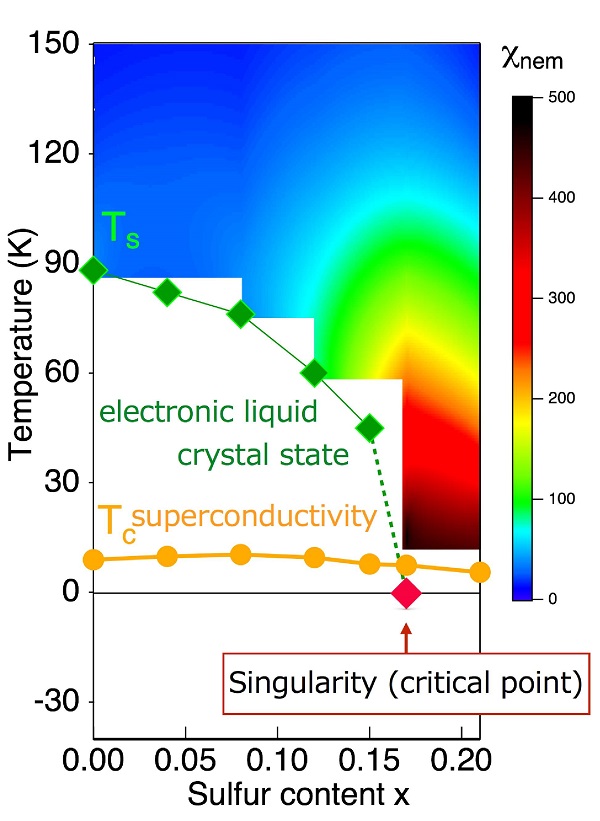Discovery may point to new source of superconductivity Non-magnetic electronic state and its singularity discovered in iron-based superconductors


Electronic liquid crystal state and its singularity in iron-based superconductors
Solid diamonds ◆ in this figure represent temperatures at which electrons start behaving like liquid crystals, and solid circles ● indicate superconducting transition temperatures. When sulfur is substituted for selenium in iron selenide (FeSe), the liquid crystal transition temperature becomes lower, and this state completely disappears when the sulfur content constitutes about 17 percent. Color gradation in the figure corresponds to the degree of strength (χnem) at which electrons become susceptible to liquid crystal-like states, and behavior leading to the enhancement of a singularity is observed when the liquid crystal state disappears. This behavior suggests the existence of a singularity (critical point) in non-magnetic electronic liquid crystal states (indicated by arrow).
© 2016 Suguru Hosoi.
A research team, including members from the University of Tokyo, systematically substituted one atom for another in an iron-based superconductor and discovered a new critical point (singularity) at which the electronic state of the superconductor changes drastically. This singularity is completely different to conventional singularities and may indicate a new mechanism for achieving superconductivity.
Studies on singularities offer important clues for understanding various physical phenomena, just as black holes, which are a kind of singularity, can shed light on the origin of the universe. Research on superconductors – which deals with superconductivity, or the phenomenon in which electricity transmission is achieved without loss of thermal energy – in theory suggests that anomalous electronic states emerging near these critical points serve as the source for inducing superconductivity. While magnetic critical points have previously been found in iron-based superconductors, whether a new singularity without magnetic properties existed remained unclear.
Drawing on the fact that electrons exhibit liquid crystal properties, the research team, including graduate student Suguru Hosoi and Professor Takasada Shibauchi, Department of Advanced Materials Science, School of Frontier Sciences, University of Tokyo, focused on iron selenide (FeSe), a superconductor that does not express magnetic properties, to study the effect of substituting some selenium atoms with those of sulfur (FeSe1-xSx), which have a smaller atomic radius. From this research, the team found that substituting approximately 17 percent of the selenium atoms with sulfur atoms led to the discovery of a new singularity that lacked magnetism.
By demonstrating that a new mechanism of superconductivity can be achieved through uncovering the relationship between this new singularity and superconductivity, researchers anticipate the opening of a new path toward realizing superconductivity at higher temperatures.
“In conventional superconductivity in simple metals, usually high temperature superconductivity is not realized. To produce superconductivity at higher temperatures, it is important to verify other mechanisms of superconductivity,” says Shibauchi. He continues, “The present finding of a new singular point implies the possibility of a novel liquid crystal-like origin for superconductivity, which is an important step toward the realization of a previously unexplored type of superconductivity.”
This research outcome is the result of joint research with Assistant Professor Shigeru Kasahara and Professor Yuji Matsuda, Graduate School of Science, Kyoto University.
Press release (Japanese)
Paper
, "Nematic quantum critical point without magnetism in FeSe1-xSx superconductors", Proceedings of the National Academy of Sciences of the United States of America Online Edition: 2016/07/05 (Japan time), doi: 10.1073/pnas.1605806113.
Article link (Publication, UTokyo Repository)
Links
Graduate School of Frontier Sciences
Department of Advanced Materials Science, Graduate School of Frontier Sciences
Shibauchi Laboratory, Department of Advanced Materials Science, Graduate School of Frontier Sciences






